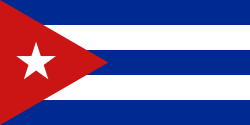Provinz Granma
| Granma | |
|---|---|
 | |
 | |
| Hauptstadt | Bayamo |
| Fläche | 8.374,24 km²[1] |
| Einwohner | 834.380 (2012)[1] |
| Bevölkerungsdichte | 99,6 EW/km²[1] |
| ISO-Code | CU-12 |
Granma ist eine Provinz im Südosten Kubas. Ihre Hauptstadt ist Bayamo. Bis zur Verwaltungsreform im Jahr 1976 war sie Teil der deutlich größeren Provinz Oriente.
Geografie
Die Provinz Granma hat eine Gesamtfläche von 8374,24 km². Im Westen bildet der Golf von Guacanayabo die natürliche Grenze, im Süden die Karibik. Die Provinzen Las Tunas, Holguín und Santiago de Cuba schließen sich im Norden, Nordwesten und Westen an. Der Gebirgszug Sierra Maestra liegt zu weiten Teilen im Verwaltungsgebiet der Provinz Granma.
An der Grenze zur Nachbarprovinz Santiago de Cuba liegt die mit 1974 m höchste Erhebung des Landes, der Pico Turquino. Im südöstlichsten Zipfel der Provinz wurde 1986 der Nationalpark Desembarco del Granma gegründet.
Geschichte
Mit der Landung der aus Mexiko kommenden Revolutionäre um Fidel Castro und Ernesto Che Guevara mit der Yacht Granma begann am 2. Dezember 1956 im Bereich der heutigen Provinz Granma die kubanische Revolution. Zu dieser Zeit hatten den Revolutionäre ihr Hauptquartier, die Comandancia General de La Plata, inmitten der Sierra Maestra errichtet. Im Gedenken an diese Ereignisse erhielt die Provinz im Zuge einer Verwaltungsreform 1976 ihren heutigen Namen.
Verwaltungsgliederung
Die Provinz Granma gliedert sich in 13 Municipios. In allen Municipios sind die Verwaltungssitze in den gleichnamigen Städten beheimatet.
| Municipio (Verwaltungssitz) | Fläche in km² (2010)[1] | Einwohner (2010)[1] | Einwohner pro km² (2010)[1] |
|---|---|---|---|
| Bartolomé Masó (Bartolomé Masó) | 637,93 | 51.868 | 81,3 |
| Bayamo (Bayamo) | 927,90 | 231.074 | 249,0 |
| Buey Arriba (Buey Arriba) | 477,79 | 32.750 | 68,5 |
| Campechuela (Campechuela) | 585,01 | 45.099 | 77,1 |
| Cauto Cristo (Cauto Cristo) | 552,74 | 21.495 | 38,9 |
| Guisa (Guisa) | 592,29 | 49.580 | 83,7 |
| Jiguani (Jiguaní) | 629,89 | 61.053 | 96,9 |
| Manzanillo (Manzanillo) | 498,95 | 131.158 | 262,9 |
| Media Luna (Media Luna) | 367,25 | 34.868 | 94,9 |
| Niquero (Niquero) | 579,77 | 41.760 | 72,0 |
| Pilón (Pilón) | 462,30 | 30.470 | 65,9 |
| Río Cauto (Río Cauto) | 1.502,14 | 47.407 | 31,6 |
| Yara (Yara) | 560,28 | 57.784 | 103,1 |
| Gesamt | 8.374,24 | 836.366 | 99,9 |
Personen (Auswahl)
- Yanet Cruz (* 1988), Speerwerferin
Weblinks
Einzelnachweise
Koordinaten: 20° 24′ N, 76° 36′ W
Auf dieser Seite verwendete Medien
Autor/Urheber: TUBS
Lage der Provinz XY (siehe Dateiname) in Cuba.
the 2 flags most likely represent the Cespedes flag. the flag used for Cuba during the ten years war. The bell on side of the shield most likely represents the slaves that Carlos Manuel de Cespedes freed from his plantation. The diagonal stripes on the left side of the shield most likely symbolize the department division of the island under Spanish colonialism, which also is part of the Cuban flag.The top side of the shield most likely represents the mountainous part of Granma. The right side of the shield represents the Granma yacht, used by Fidel Castro. The wheat grains most likely represent the economic branch of agriculture which makes up 39% of the land. Lastly the star or mullet most likely represents an independent state which is Cuba, also the same meaning that is in the star of the Cuban flag. [1]


